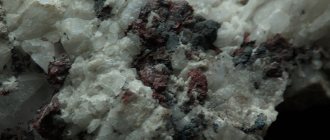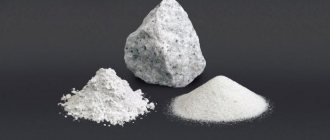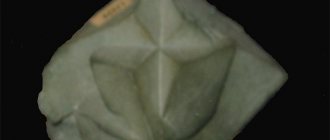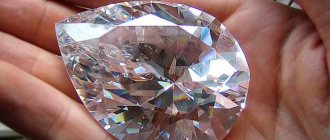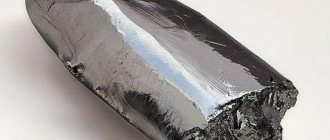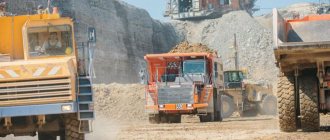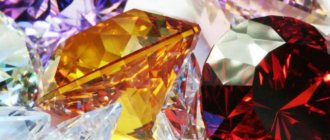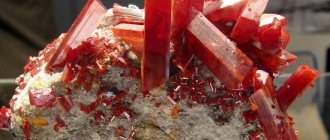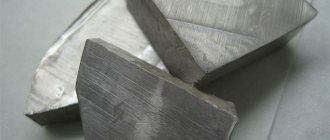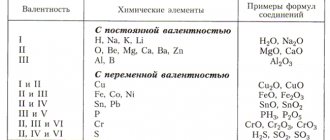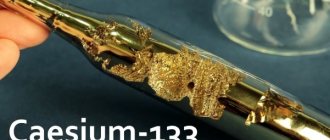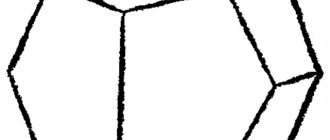Minerals are determined by physical properties, which are determined by the material composition and structure of the crystal lattice of the mineral. These are the color of the mineral and its powder, luster, transparency, the nature of fracture and cleavage, hardness, specific gravity, magnetism, electrical conductivity, malleability, fragility, flammability and odor, taste, roughness, fat content, hygroscopicity. When determining some minerals, their ratio to 5-10% hydrochloric acid can be used (carbonates boil).
Mineral color
The question of the nature of the color color of minerals is very complex. The nature of the colors of some minerals has not yet been determined. At best, the color of a mineral is determined by the spectral composition of the light radiation reflected by the mineral or is determined by its internal properties, some chemical element included in the mineral, finely scattered inclusions of other minerals, organic matter, and other reasons. The coloring pigment is sometimes distributed unevenly, in stripes, giving multi-colored patterns (for example, in agates).
Irregular stripes of agate
Some transparent minerals change color due to the reflection of light falling on them from internal surfaces, cracks or inclusions. These are phenomena of rainbow coloring of the minerals chalcopyrite, pyrite and iridescence - blue, blue tints of labradorite.
Some minerals are multicolored (polychrome) and have different colors along the length of the crystal (tourmaline, amethyst, beryl, gypsum, fluorite, etc.).
The color of a mineral can sometimes be a diagnostic sign. For example, aqueous copper salts are green or blue. The nature of the color of minerals is determined visually, usually by comparing the observed color with well-known concepts: milky white, light green, cherry red, etc. This feature is not always characteristic of minerals, since the colors of many of them vary greatly.
Often the color is determined by the chemical composition of the mineral or the presence of various impurities, which contain chemical elements-chromophores (chrome, manganese, vanadium, titanium, etc.). The mechanism for the appearance of this or that color on gems is still not always clear, since the same chemical element can color different gems in different colors: the presence of chromium makes a ruby red and an emerald green.
Forms of occurrence of minerals in nature
General information about minerals
Minerals are natural chemical compounds or native elements formed during various physical and chemical (geological) processes. They make up various rocks of the earth's crust and can be seen with the naked eye.
In nature, minerals can be found in solid, liquid and gaseous states.
The science that studies minerals in a solid state is called
mineralogy .
Rock-forming minerals
Currently, more than 7,000 minerals and their varieties are known, but very few of them are widely distributed in rocks.
Such minerals are called rock-forming minerals
.
crystalline in their internal structure
or
amorphous
.
In crystalline substances, unlike amorphous ones, atoms and ions occupy strictly defined positions in space, creating crystal lattices
(Fig. 1).
A clear expression of the internal structure of minerals is their regular external shape of polyhedra, which are called crystals
(Fig. 2).
Forms of occurrence of minerals in nature
In nature, minerals are found both in the form of single crystals and their intergrowths, and in the form of clusters called mineral aggregates
(mineral aggregates).
Among minerals, three groups with a characteristic appearance are distinguished based on their shape:
isometric, equally developed in all three directions - magnetite, pyrite, garnet (Fig. 2, I);
2. elongated in one direction - prismatic, columnar, needle-shaped and radiant - barite, quartz, etc. (Fig. 2,II)
3. elongated in two directions - tabular, lamellar, leafy and scaly - muscovite, chlorite, etc. (Fig. 2,III)
The morphology of mineral aggregates is also diverse: drusen, secretions, nodules, dendrites, sinter and granular aggregates, earthy aggregates.
Drusen are intergrowths of crystals attached at one end to the rock.
For their formation, open cavities are required in which free crystal growth can occur (Fig. 3, A, B).
Secretion ( geode) tonsils - formed when minerals fill voids in rock. For secretion, a concentric structure is typical, because their filling with mineral matter occurs from the periphery to the center. Small secretions in effusive rocks are called tonsils, and large secretions with a void in the middle are called geodes (Fig. 3, D).
Concretions are spherical concretions. The growth of nodules goes from the center to the periphery. By structure, nodules are more often found to be concentric layered or radially radiant. Oolites are similar to nodules - small, up to 10 mm, pea-like formations with an internal concentric structure. Formed in an aquatic environment.
Dendrites - resemble bizarrely shaped plant branches that form in thin cracks as a result of rapid crystallization of the mineral (Fig. 3, G).
A striking example of dendrites is the dendrites of ice crystals on window glass in winter.
Sinter aggregates (Fig. 3, E), in the form of icicles, buds, and clusters, are most widespread in karst caves. The deposits hanging in the form of icicles from above are called stalactites
, and growing towards them from below are
stalagmites
.
Granular aggregates are a random accumulation of grains of one or several minerals of various sizes (fine-, medium-, coarse-grained) (Fig. 3, B).
Earthy aggregates are an accumulation of loose, fine-grained masses of a mineral.
In order to learn how to identify minerals by eye by external signs, you need to know their simplest physical properties: color, line color, transparency, luster, hardness, cleavage and fracture, as well as take into account the shape of crystals and the morphology of mineral aggregates.
The color of minerals is an important diagnostic feature.
Minerals can have a wide variety of colors and all sorts of shades.
There are colorless and transparent minerals.
In practice, the color is determined by eye by comparison with well-known objects: milky white (quartz), brass yellow (pyrite). Some minerals, depending on the chemical composition and impurity elements, can change their color, such as quartz, which has many varieties (amethyst - blue, morion - black, etc.).
The color of the line is the color of the mineral in powder.
For some minerals (pyrite, hematite), it differs from the color of the mineral itself. The powder can be obtained by passing a grain of the mineral over a white, rough porcelain plate.
Luster is the ability of a mineral to reflect light from its surface. According to their luster, all minerals can be divided into three groups: with a metallic, semi-metallic and non-metallic luster.
Metallic shine
– strong shine characteristic of metals.
Such luster is observed in native metals (gold, silver, platinum), many sulfides and oxides of iron.
Semi metallic luster
– has the appearance of tarnished metal.
Non-metallic luster
(glassy, greasy, pearlescent, silky, matte, diamond) is characteristic of most transparent minerals.
Its varieties are determined by comparing it with the brilliance of known substances.
Transparency is the ability of a mineral to transmit light in very thin plates (sections). Based on the degree of transparency, minerals are divided into transparent and opaque minerals.
A B
B D D
E F
Rice. 3. Morphology of mineral aggregates
A – quartz druse; B – granular aggregate of dolomite; B – druse of pyrite crystals; G – amethyst geode; D – limonite sinter aggregate; E – hair-like asbestos aggregate; F – manganese dendrites
Cleavage is the ability of minerals to split (or split) in one or several directions with the formation of smooth, parallel cleavage surfaces (Fig. 4).
The presence of cleavage and its character are clearly visible in the chips of mineral grains. There are 5 types of cleavage.
Rice. 4. Mineral cleavage
A – perfect calcite; B – perfect halite
Very perfect cleavage
– manifests itself in minerals that are very easily (for example, a fingernail) split into individual thin leaves or plates, forming mirror-like planes (mica, gypsum, chlorite).
Perfect cleavage
(Fig. 4) differs in that the mineral splits with a weak hammer blow into smooth parallel plates (rhombohedra - calcite, cubes - halite).
Average cleavage
characteristic of minerals, the splitting of which produces both smooth and uneven cleavage surfaces (feldspars).
Imperfect cleavage
appears in many minerals.
In this case, when the mineral is split, surfaces with an uneven, irregular fracture, reminiscent of shell surfaces, predominate.
It is important not to confuse the cleavage planes that are visible on chips with the crystal faces: the cleavage planes have a stronger shine and a fresher appearance. In addition, they form a series of surfaces parallel to each other.
Hardness is the degree of resistance of a mineral to external mechanical influences (scratching, cutting, indentation).
The hardness of minerals varies from 1 to 10 and is determined on the Mohs scale.
Minerals with known constant hardness are used as standards.
Mohs scale
| 1. Talc Mg3(OH)2[Si4O10] | 6. Orthoclase K[AlSi3O8] |
| 2. Gypsum CaSO4×2H2O | 7. Quartz SiO2 |
| 3. Calcium CaCO3 | 8. Topaz Al2(F,OH)2[SiO4] |
| 4. Fluorite CaF2 | 9. Corundum Al2O3 |
| 5. Apatite Ca5(F,Cl)[PO4]3 | 10. Diamond C |
In practice, it is enough to know that the hardness of the nail is 2 - 2.5; copper needle – 3.5; glass, razor, steel needle – 5; quartz – 7.
To determine the relative hardness of two minerals, a sharp edge of one is drawn across the surface of the other (with pressure). A harder mineral leaves a scratch on the surface of a softer mineral, and a softer mineral on the surface of a harder one sometimes leaves a mark that can be easily erased with a finger. For example, the mineral under study is scratched by quartz, and it itself scratches glass (or apatite).
Thus, the hardness of the mineral under study will be less than 7 (quartz) and more than 5 (apatite, glass), i.e. it is equal to 6.
Density _ Based on density, all minerals can be divided into three categories: light
– with a density of up to 2,500 kg/m3 (oil, coal, gypsum, halite);
medium
- with a density of up to 4,000 kg/m3 (calcite, quartz, feldspars, micas) and
heavy
- with a density of more than 4,000 kg/m3 (pyrite, magnetite, gold).
In practice, to quickly approximately determine the density, they use weighing the mineral on the hand with the rating “heavy”, “medium”, “light”.
In addition to the physical properties listed above, some minerals have strong magnetic properties, for example, magnetite, which is manifested in its effect on the magnetic compass needle.
Other minerals react differently with acids. So, for example, calcite (CaCO3) boils violently under a drop of hydrochloric acid (HCl), and dolomite (CaMg(CO3)2) “fizzes” only in the line, i.e. the reaction with the release of CO2 proceeds extremely slowly and only within the limits where the mineral is ground into powder.
Stroke color
A more reliable diagnostic feature than the color of a mineral is the color of its powder, which is left when the test mineral scratches the matte surface of a porcelain plate. In some cases, the color of the line coincides with the color of the mineral itself, in others it is completely different. So, in cinnabar the color of the mineral and powder is red, while in brass-yellow pyrite the color is greenish-black. The devil is given by soft and medium-hard minerals, while hard ones only scratch the plate and leave grooves on it.
Color of mineral lines on a porcelain plate
Transparency
Based on their ability to transmit light, minerals are divided into several groups:
- transparent (rock crystal, rock salt) – transmitting light, objects are clearly visible through them;
- translucent (chalcedony, opal) - objects through which objects are difficult to see;
- translucent only in very thin plates;
- opaque - they do not allow light to pass through even in thin plates (pyrite, magnetite).
Cleavage
The phenomenon of cleavage in minerals is determined by the cohesion of particles inside crystals and is determined by the properties of their crystal lattices. The splitting of minerals occurs most easily parallel to the densest networks of crystal lattices. These networks most often and in the best development appear in the external boundary of the crystal.
The number of cleavage planes in different minerals varies, up to six, and the degree of perfection of different planes may not be the same. The following types of cleavage are distinguished:
- very perfect , when the mineral, without much effort, splits into individual leaves or plates with smooth shiny surfaces - cleavage planes (gypsum).
- perfect , detected by a light blow to the mineral, which crumbles into pieces limited only by smooth shiny planes. Uneven surfaces not along the cleavage plane are very rarely obtained (calcite splits into regular rhombohedrons of different sizes, rock salt into cubes, sphalerite into rhombic dodecahedrons).
- average , which is expressed in the fact that when a mineral is struck, fractures are formed both along the cleavage planes and on uneven surfaces (feldspars - orthoclase, microcline, labradorite)
- imperfect . Cleavage planes in minerals are difficult to detect (apatite, olivine).
- very imperfect . There are no cleavage planes in the mineral (quartz, pyrite, magnetite). At the same time, sometimes quartz (rock crystal) is found in well-cut crystals. Therefore, it is necessary to distinguish the natural edges of the crystal from the cleavage planes that appear when the mineral is fractured. The planes can be parallel to the edges and have a more “fresh” appearance and a stronger shine.
↑ Anisotropy of crystal properties
The anisotropy of the properties of crystals is caused by the anisotropy of their spatial lattice. This means that different faces, edges, and vertices of a crystal have different properties: they shine differently, the hardness of the crystal on them is different, they often have a different color, etc. Anisotropy of properties is expressed in the fact that in non-parallel directions properties on one and the same facets are different. For example, the edges of diamond crystals are scratched in different directions in different ways - this is taken into account when polishing diamonds. All physical properties manifest themselves anisotropically in the volume of the crystal: optical, electrical, thermophysical properties, hardness, etc.
The degree of anisotropy of crystals depends on their symmetry. If you draw straight lines through the center of the crystal, then among them you can distinguish symmetrically equal, unit and polar straight lines (directions).
Symmetrically equal are those lines (or directions) repeated in a crystal that are derived from one another using symmetry elements. The properties of crystals in these directions are repeated.
Single lines are those straight lines (directions) that are the only ones, unique in the crystal. The properties of crystals along these directions differ from the properties along other directions. There are no unit directions in cubic crystals, because they are symmetrically equal and repeated many times. The anisotropy of properties in cubic crystals is very weak. As a result, we can say that cubic crystals are isotropic (an isotropic body has equal properties in all directions).
In crystals of hexagonal, trigonal and tetragonal systems there is always one single, unit, i.e. non-repeating direction. These are the symmetry axes L6, L4, L3. This axis is always the same and is never repeated. All other directions in these crystals are repeated many times.
In rhombic crystals, there are three unit directions. In crystals of the monoclinic system there are many unit directions, but in the triclinic system all directions are unit. The anisotropy of properties in these crystals is most pronounced.
Polar directions are those of the symmetrical or unit directions whose ends cannot be combined using symmetry elements. A clear example of this is the third order axis in tourmaline. Its upper end is incompatible with the lower, both ends are unequal. This follows from the features of the crystal structure of minerals, the main element of which is rings of silicon-oxygen tetrahedra (Si6O18)12–, the vertices of which are turned in one direction. A consequence of the polarity of L3 are the pyroelectric properties of tourmaline: when heated, opposite electrical charges arise at the top and base. The color of multicolor tourmaline crystals and their growth rate are different at different ends of the crystals.
Kink
The nature of the surface formed during the fracture (splitting) of a mineral is different:
- An even fracture if the mineral splits along cleavage planes, as, for example, in mica, gypsum, and calcite crystals.
- A step fracture occurs when there are intersecting cleavage planes in a mineral; it can be observed in feldspars and calcite.
- An uneven fracture is characterized by the absence of shiny areas of splitting along the cleavage, as, for example, in quartz.
- Granular fracture is observed in minerals with a granular-crystalline structure (magnetite, chromite).
- Earthy fracture is characteristic of soft and highly porous minerals (limonite, bauxite).
- Conchoidal - with convex and concave areas like shells (apatite, opal).
- Splintered (needle-shaped) - an uneven surface with splinters oriented in one direction (selenite, chrysotile-asbestos, hornblende).
- Hooked - hooked irregularities appear on the surface of the split (native copper, gold, silver). This type of fracture is characteristic of malleable metals.
Smooth fracture on mica. Rough fracture on rose quartz. Stepped fracture on halite. © Rob Lavinsky Granular fracture of chromite. © Piotr Sosonowski Earthy fracture of limonite Conchoidal fracture on flint Splinter fracture on actinolite. © Rob Lavinsky Hooked fracture on copper
Forms of mineral release. Crystal morphology
How diverse and amazing bodies nature gives birth to in the depths of the earth,
well known to those who have ever had the pleasure of inspecting a good
collection of minerals and did not hesitate to crawl through dark and dirty mines.
M.V. Lomonosov
Minerals amaze us with their natural beauty and grace, harmony of colors and appearance. When forming an idea of minerals, the shape of crystals and mineral aggregates with which it can be represented in nature plays an important role. The shapes of crystals and aggregates are sometimes an important diagnostic feature for a particular mineral species. For example, scapolite is named from the Greek “scapos” - rod, as it always forms columnar crystals; akmite is named for the pointed shape of its crystals; The word "spinel" comes from the Latin "spinella" - a thorn, based on its "sharp" octahedral crystals. But first things first. A crystal (from the Greek “kristallos” - solidifying in the cold) is a solid body consisting of regularly arranged atoms and ions, capable of taking the form of crystalline polyhedra.
Okenite. Pervomaisky quarry
The geometric appearance of crystals often differs from the perfect polyhedrons that they should be represented as. To characterize the morphology of crystals, two different terms are used - appearance and habit. The appearance of a crystal is its general appearance. The appearance of crystals is determined by their deviation from isometry.
Axinite. Dalnegorsk
All the variety of crystal appearances is divided into three types:
Isometric (the crystal is evenly developed in all three directions).
Cuprite. Rubtsovskoye field
Elongated (the crystal is elongated in one direction). The crystals are columnar, columnar, needle-shaped, hair-like and others.
Flattened (the crystal is elongated in two directions). Crystals are tabular, leafy, scaly and others.
Habitus (from the Latin “habitus” - appearance) is a more complete and strict concept. Habitus determines the appearance of crystals by the predominant development of the faces of certain simple forms. For example, the habit of columnar scapolite crystals can be characterized as elongated tetragonal prismatic. There are also unusual skeletal crystals. They are well known to us from snowflakes. Upon closer examination of the ice crystal, we will see that if we outline it, we will get an ordinary hexagonal crystal. Skeletons are apical and edge forms of crystal growth. Such forms of crystals are characteristic of ammonia and halite, galena, quartz and other minerals. Under laboratory conditions, skeletal crystals usually grow from highly supersaturated solutions. Let us consider two cases of the formation of a crystal of this type.
Skeletal pyrite crystal. Cape Frenchwoman. Crimea.
Firstly, such crystals grow when the diffusion of a substance to the crystal is difficult, so the crystal grows faster with those parts of it that have a larger specific surface area, that is, these are the protruding parts of the crystal, namely the tops and edges.
Secondly, such crystals are formed when the solution contains impurities that are not included in the crystal, but settle on its faces. These impurity particles are repelled by the growing crystal, their density increases in the center of the faces, and at the vertices it is less, so the growth of vertices and edges is faster than in the center of the faces.
A unique variety of skeletal crystals is also fantastic - case-shaped. Such crystals were experimentally obtained from olivine in a viscous melt. Occasionally, such crystals are observed in apatite and beryl when they grow under special conditions. Crystals with more complex morphology are also known. They seem to be split at the edges, that is, each individual in them seems to be slightly bent away from the main body of the crystal. Split crystals include, for example, sheaf-shaped aggregates of gypsum, tourmaline and quartz, rosettes of gypsum and hematite, mosaic block crystals, rosettes and parquet crystals.
Hematite. San Gottard Mount Fibbia. Switzerland
Pseudomorphosis of celestine on gypsum. Vodinskoye field. Quarry Ts4
Crystal splitting occurs for various reasons. Firstly, it occurs in the case when there are microparticles in the medium that are adsorbed by the surface of the crystal (that is, not repelled by the surface of the crystal) and at the same time fit into its crystalline structure. The layer grows on the impurities and continues to grow, but in the other direction. In experiments on the deflection of a part of a crystal, the angle of deflection usually does not exceed 20 - 30 minutes, the “splitting off” is repeated again and again, and gradually a “fan” or “sheaf” of diverging crystals is formed from individual individuals. Secondly, splitting occurs at scratches, boundaries of twins and microblocks, slightly rotated during mechanical deformations of the crystal. Thirdly, the splitting of crystals may be a consequence of heterometry (different sizes of the same interplanar distances in different parts of the zonal crystal). This mechanism is used, for example, to split galena crystals. Observations and experiments have proven that the edges of not all simple forms developed on a crystal are split. When describing the morphology of crystals, one should take into account both the relief of the surfaces of the faces and the possibility of twinning of crystalline individuals. More details about them are written in other articles.
In nature, not single crystals are widespread, but their intergrowths or mineral aggregates. Mineral aggregates are polymineral (consisting of grains of several minerals) and monomineral (consisting of grains of one mineral). According to the grain size, the aggregates are coarse-grained - more than 5 mm in diameter; medium-grained - from 1 to 5 mm and fine-grained - less than 1 mm in diameter. In particular, a huge number of igneous metamorphic rocks, as well as some sedimentary rocks and some types of sulfide ores, are composed of granular aggregates. The direction of influx of solutions and the conditions of deposition also determine the formation of crystal aggregates with distinct shapes, which can be characteristic of individual minerals. Some of these aggregates are given names, often derived from Latin or Greek roots and describing their morphology.
The growth of crystals in free space leads to the formation of drusen.
Quartz. Perekatnoe
A druse is a group of crystals that have grown perpendicular or nearly perpendicular to the surface of a crack, vein wall, or cavity in the rock (comb aggregates or brushes). If the size of the crystals is negligible, then crystalline crusts are formed. The crystals in this case have a common base.
During the formation of drusen, geometric selection is important (the diagram is shown above: 1 - the beginning of crystal growth; 2 - drusen formation, 3 - brush formation). The essence of this phenomenon is the growth of initially single, differently oriented crystals on the wall. Then, growing, they come into contact with each other, preventing themselves from growing. As a result, only those crystals continue to grow whose apex is directed towards free space, usually perpendicular to the surface.
Concretion is a form of rounded mineral release that occurs in rock of a different composition during diagenesis. In the center of the concretion there is often a grain, which serves as a seed for its growth. The composition of nodules is monomineral: carbonate, phosphate and others. Recently, large deposits of ferromanganese nodules have been found at the bottom of the Pacific Ocean, which in the future will undoubtedly be of interest to humans. Concretions are characteristic of pyrite, calcite, and phosphorite. The sizes of such formations can vary from several millimeters to several tens of centimeters.
Phosphorite. Podillya. Ukraine
Agate. Ijevan. Armenia
Goethite. Novo-Sheleinsky iron mine, Verkhneufaleyskaya group of (Fe-Ni) deposits, Verkhneufaleysky district, Chelyabinsk region
Rosasite. Ojuella mine, Mexico
Secretion occurs when a cavity in a rock is filled with a substance from the periphery to the center. A large-sized secretion is called a geode - a round, oval void in the rock, on the walls of which minerals have crystallized; small - amygdala - small, round or almond-shaped light inclusions in effusive rock, usually of basic composition. The oolitic aggregate of the mineral consists of small spheres and seems to resemble fish eggs. Such an aggregate is formed in cases where a mineral crystallizes from a solution on some grain, as if covering it with shells overlapping each other. They have a concentric-shell structure, due to the rhythmic change of mineral formation conditions. Oolites are formed in bottom, lake, sea silts and hot springs.
Kidney-shaped (collomorphic, tuberous) aggregates consist of many adjoining buds, each of which, like a spherulite, has a radial structure, not always visible to the naked eye. Kidney-shaped aggregates are most characteristic of malachite and goethite. Their formation occurs due to group growth and geometric selection of spherulites. As they grow, only those spherulites that were on the convexities of the substrate remain. Most often, kidney-shaped aggregates are formed in various voids in near-surface zones of destruction and weathering of rocks.
Spherulite is a mineral aggregate, represented by an almost ideal spherical shape and having a size from fractions to 1 - 2 cm. Spherulites are formed on the walls of various voids in rocks as a result of split growth of crystals, or they, like a concretion, have a core on which growth mineral. Due to geometric selection or cramped conditions, crystals can grow only by radiating from the center of the spherulite.
Okenite. Pervomaisky quarry. Crimea.
Framboids are spherical aggregates of small sizes (from microscopic to 2 mm), externally resembling nodules or oolites, but they are composed of a solid aggregate of identically faceted isometrically “stacked” grains. Externally, this form of release resembles the core of a ripe pomegranate. Framboids are typical of pyrite and marcasite and are formed mainly due to the crystallization of colloidal masses of matter during the diagenetic transformation of bottom silts and gels in modern peat bogs, swamps, lakes and marine sediments. Sulfide framboids are also known in sedimentary and metamorphic rocks of different ages.
Dense aggregates of minerals are represented by a continuous mass, in which individual crystals are so small that they are barely distinguishable. The structure of such masses can be microcrystalline (when the crystals are visible under an optical microscope), and cryptocrystalline, when individual crystals are difficult to distinguish even under a microscope. For example, agate and flint are cryptocrystalline forms of quartz.
Agate. Kara-Dag. Crimea
No less interesting are the cluster-shaped aggregates of minerals, reminiscent of bunches of grapes. This form is usually obtained by minerals precipitated as colloidal gels that have been subjected to surface tension. Example: malachite and romaneshite.
Coral-like aggregates of minerals are sometimes observed in calcite and aragonite. They are represented by branched, roughly rounded and intertwining forms. The crystals are so small that they could be classified as a dense form. An example is the appearance of calcite in marble. Also often observed in sulfide minerals in mixed ores.
Dendritic aggregates of minerals are among the most beautiful. Dendrite is the result of apical and edge growth of crystals, which occurs when a substance diffuses unevenly towards the crystal. These are bizarre single crystals that resemble a branching plant. Interestingly, in dendrites, each “branch” is faceted; the angles of branching exactly correspond to the angles between the faces of ordinary crystals. The formation of dendrites is especially characteristic of native elements, pyrolusite.
Native copper. Dzhezkazgan. Kazakhstan.
Pyrolusite. Dendrites
Mossy aggregates are miniature dendritic ones.
Lamellar aggregates of minerals are represented by thin leaves or plates, as, for example, in mica.
Thread-like aggregates are thin and long. Characteristic of millerite.
Stalactite aggregates of minerals are represented by hanging masses converging on a cone, which can merge with formation cavities (stalagmites) growing upward from the lower level, forming columns. Stalagmites are formed by the deposition of a substance dissolved in water that seeps through cracks in the rock. They are characteristic mainly of calcite deposits in limestone caves. But other minerals can be formed in the same way.
Section of a stalactite. Marble Cave. Crimea.
The pisolite aggregate of the mineral resembles the oolitic one, but in this case the spheres range in size from a pea to a plum.
Network aggregates of minerals consist of many cells that arise as a result of the mutual intersection of crystals. This form of discharge is characteristic of cerussite and crocoite.
Rutile. Karelia.
Nodule aggregates of minerals form isolated ellipsoidal segregations. As an example, we can point to siderite nodules in shales.
The mastoid aggregates of minerals form rounded surfaces that intersect to form open V-shaped grooves, often resembling irregular stitches. Hematite often has this shape.
Radially radiant mineral aggregates are identified by radially arranged needle-shaped or plate-shaped crystals. An example is the famous astrophyllite “sun”, as well as some aggregates of pyrophyllite, wavellite, gypsum and tourmaline in the case of certain special conditions of their crystallization.
Astrophyllite. Kola Peninsula
Wire-like aggregates of minerals are observed in native silver and gold.
The bean-shaped aggregates of minerals resemble oolitic ones, but the spheroids in them are the size of a pea. Often observed in bauxite, where their development is probably due to deposition from a colloidal environment.
Bauxite. Republic of Guinea (W), vicinity. Kindia town, Kindia bauxite deposit
Massive aggregates of minerals are represented by intergrown crystals that do not form distinct individuals.
A cryptocrystalline aggregate of a mineral is a dense, in some cases almost glassy, deposits consisting of submicroscopic grains.
The feathery aggregate of the mineral consists of feather-like scales.
The helicite aggregate of the mineral is twisted and twisted, in some cases intertwined like branched coral. This also includes formations that mineralogists often call coralloid.
Fibrous (parallel-columnar) aggregates of minerals form in cracks. Examples include veins of selenite, serpentine asbestos, and columnar calcite.
Tobermoritis. Pervomaisky quarry. Crimea
Bissolite. Maderantal, Uri, Switzerland
Their formation can occur in different ways. In the first case, such aggregates are formed in open cracks: first, druses grow on the walls according to the principle of geometric selection; then, growing, they close together and form such fantastic aggregates. In another way, such an aggregate can form in gradually opening cracks, when the opening speed is less than or equal to the growth rate of individuals. First, the crack is filled with a granular mineral aggregate in the form of a continuous thin vein. Then, when the crack continues to open slightly, the grains, resting against each other, can only grow following the moving apart walls of the crack. In other cases, such aggregates are formed when they grow from hairline cracks in both directions; their growth follows the principle of the formation of an aggregate of the first or second kind.
Other, not at all flashy, but possibly very important forms of release of some, including rare, minerals are also known.
Earthy masses are loose, soft, mealy aggregates of an amorphous or cryptocrystalline structure, sooty (black) or ocher (yellow, brown and other bright colors). Most often they are formed during chemical weathering of rocks and in the oxidation zone of ores (for example, manganese).
Plaques and adhesives are thin films of various secondary minerals that cover the surface of crystals or rocks. These are, for example, the application of malachite to cracks in rocks containing copper sulfide deposits.
Malachite, chrysocolla. Fiolent. Crimea
Efflorescences are loose crusts, films, deposits, often fluffy or mossy, that periodically appear in dry weather and disappear in rainy weather, on the surface of dry soils, rocks and along cracks in them. These formations are most often composed of very easily water-soluble minerals: sulfates, chlorides of various metals
DMITRY TONKACHEEV, 2005
(Illustrations: samples from the museum's collections)
Hardness
The hardness of minerals is the degree of resistance of their outer surface to the penetration of another, harder mineral and depends on the type of crystal lattice and the strength of the bonds of atoms (ions). Hardness is determined by scratching the surface of the mineral with a fingernail, knife, glass, or minerals of known hardness from the Mohs scale, which includes 10 minerals with gradually increasing hardness (in relative units).
The relativity of the position of minerals in terms of the degree of increase in their hardness is visible when compared: precise determinations of the hardness of diamond (hardness on a scale is 10) showed that it is more than 4000 times higher than that of talc (hardness - 1).
Mohs scale
| Mineral | Hardness |
| Talc | 1 |
| Gypsum | 2 |
| Calcite | 3 |
| Fluorite | 4 |
| Apatite | 5 |
| Feldspar | 6 |
| Quartz | 7 |
| Topaz | 8 |
| Corundum | 9 |
| Diamond | 10 |
The main mass of minerals has a hardness of 2 to 6. Harder minerals are anhydrous oxides and some silicates. When determining a mineral in a rock, you need to make sure that it is the mineral that is being tested, and not the rock.
↑ Physical and chemical properties of minerals
There is a very close relationship between the chemical composition, crystal structure and physical properties of the mineral. The study of physical properties allows us to judge the chemical composition and structure of the mineral. In addition, physical properties may be of great interest for certain areas of technology (high hardness of diamond, corundum; optical properties of quartz, fluorite, calcite). In addition, the physical properties of minerals allow them to be identified in the field.
Physical properties include optical, mechanical, electrical, magnetic, thermophysical properties and density. There are also chemical properties, which include the degree of reactivity of minerals, the characteristics of their interaction with various reagents, and solubility. There are also properties that can be called physicochemical (for example, the nature of the wettability of its grains).
Geophysical methods for searching and exploring mineral deposits (gravity prospecting, magnetic prospecting, electrical prospecting, seismic prospecting) are based on various physical properties of crystals (density, electrical and magnetic properties). The nature of the mechanical properties determines the method of grinding crystals when processing their ores. Density affects the ability to remain in the concentrate or be washed out of it, i.e. determines the method of ore beneficiation.
Specific gravity
The specific gravity varies from 0.9 to 23 g/cm3. For most minerals it is 2–3.4 g/cm3; ore minerals and native metals have the highest specific gravity of 5.5–23 g/cm3. The exact specific gravity is determined in the laboratory, and in normal practice, by “weighing” the sample on the hand:
- Light (with a specific gravity of up to 2.5 g/cm3) - sulfur, rock salt, gypsum and other minerals.
- Medium (2.6 - 4 g/cm3) - calcite, quartz, fluorite, topaz, brown iron ore and other minerals.
- With a high specific gravity (more than 4). This is barite (heavy spar) - with a specific gravity of 4.3 - 4.7, sulfur ores of lead and copper - specific gravity of 4.1 - 7.6 g / cm3, native elements - gold, platinum, copper, iron, etc. d. with a specific gravity from 7 to 23 g/cm3 (osmic iridium - 22.7 g/cm3, platinum iridium - 23 g/cm3).
Mineral aggregates and their varieties
Under natural conditions, most minerals are rarely found in the form of well-formed crystals; irregular accretion of several crystals with each other is much more common. Such accretions are called mineral aggregates.
granular aggregates predominate
, in which many crystals are closely intergrown. Since the crystals in such aggregates grow simultaneously and constrain each other in growth, they usually have a regular cut only on some sides or lack it at all.
Based on the size of mineral deposits, coarse-, medium- and fine-grained aggregates are distinguished, and according to the shape of the grains - fibrous, needle-shaped, lamellar, scaly, sugar-like, etc.
Among other mineral aggregates, the most common are:
Druze
– irregular accretions of crystals attached at one end to a common base, due to which only their free ends are well-cut.
Brushes –
also intergrowths of columnar crystals attached to a common base, but oriented parallel to each other, as a result of which only the heads of the crystals are visible.
Spherulites and sheaf-like aggregates
– are spherical, hemispherical or sheaf-shaped aggregates of various sizes, formed by thin fibers radiating radially from the center.
Concretions
are obtained if a mineral substance is precipitated from solution onto some solid particles, for example, grains of sand or fragments of shells, covering them as if with concentric shells overlapping one another.
Secretions
- rounded spherical or flattened mineral accumulations formed in porous rocks as a result of sequential deposition of mineral matter from the periphery to the center.
Geodes
represent cavities in rock, partially filled with mineral matter. In this case, the deposition of mineral matter occurs on the walls of the cavity, and in the middle there remains free space where well-cut crystals can form. If you break a large geode with crystals inside into several parts, you can get beautiful druses or brushes.
Dendrites
are obtained through very rapid crystallization of minerals (skeletal growth of only tops and edges), as well as during crystallization in thin cracks, when individual crystals branch complexly, resembling the branches of a tree (remember the bizarre patterns of ice dendrites on windows in frosty weather), or form a “vegetative” pattern delicate black “twigs” of pyrolusite, as if painted on the walls of cracks in rocks.
Sinter formations
arise as a result of the deposition of mineral matter on the surface of other aggregates from aqueous solutions during their gradual evaporation. These include kidney-shaped aggregates (outwardly resembling animal kidneys), stalactites and stalagmites, etc.
Many minerals are also found in nature in the form of thin crusts, films and lubricants.
on the surface of other minerals or rocks.
Radioactivity
Radioactivity can serve as an important diagnostic sign. Some minerals containing radioactive chemical elements (such as uranium, thorium, tantalum, zirconium, thorium) often have significant radioactivity, which is easy to detect with household radiometers. To test for radioactivity, the background amount of radioactivity is first measured and recorded, then a mineral is placed near the detector of the device. An increase in readings by more than 15% indicates the radioactivity of the mineral. Radioactive minerals are: abernathyite, bannerite, gadolinite, monazite, orthite, zircon, etc.
Glow
Glowing fluorite
Some minerals that do not glow by themselves begin to glow under various special conditions (heating, irradiation with X-rays, ultraviolet and cathode rays; when broken and even scratched). There are the following types of luminescence of minerals:
- Phosphorescence is the ability of a mineral to glow for minutes and hours after exposure to certain rays (willite glows after irradiation with short ultraviolet rays).
- Luminescence is the ability to glow when irradiated with certain rays (scheelite glows blue when irradiated with ultraviolet and rays).
- Thermoluminescence - glow when heated (fluorite glows purple-pink).
- Triboluminescence - glow at the moment of scratching with a knife or splitting (corundum).
Asterism
Asterism or star effect
Asterism, or the star effect, is characteristic of few minerals. It consists in the reflection (diffraction) of light rays from inclusions in the mineral, oriented along certain crystallographic directions. The best representatives of this property are star sapphire and star ruby.
In minerals with a fibrous structure (cat's eye), there is a thin strip of light that can change its direction when the stone is turned (iridescence). The playful light on the surface of opal or the shining peacock colors of labradorite are explained by the interference of light - the mixing of light rays when they are reflected from layers of packed silica beads (in opal) or from the thinnest lamellar crystal growths (labradorite, moonstone).
